Quince Brule Tarts
Quinces were introduced to Britain during the late 16th century from the Mediterranean. It made its appearance at the end of a large banquet, as it helped with the digestion and kept the diners regular. Well that is a bit of history and it makes me giggle.
I have far more fond memories of this perfumed and fragrant fruit ,as my grandmother use to poach and bottle the quinces for the winter months. My grandmother had a huge cool larder ,with floor to ceiling cupboards with glass doors. I remember seeing these light pink fruits sitting in their sweet syrup and Grandmother would open a jar or two after Sunday lunch.She would serve them warm with thick sweet custard. I use to rub the soft poached quince against the roof of my mouth with my tongue, as I liked the unique grainy texture with the fragrant perfumed aroma.
I’m pretty pleased with this recipe! As I walked through Borough Market gulping at the piles of fruit and vegetables in season I came across these quinces. Obviously the first thing that jumps to mind is the quince cheese synonymous with Spain and tapas. But then quinces has it’s own meaning for me, for that reason I thought it would be a challenge to come up with a unique British Larder recipe using these aromatic and fragrant beauties.Quince curd is delicious with it’s rich perfumed fragrance and unique grainy but natural texture. It makes a brilliant and alternative filling for cakes, cupcakes and tartlets. By caramelising the tops of these quince brulee tarts it adds yet another texture and makes this recipe even more unique.
Quinces goes well with a wide variety of dishes and ingredients such as duck, cheese, whole grains and many more.


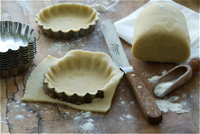 Sweet Short Crust Pastry
Sweet Short Crust Pastry
- 460g plain all purpose flour
- 280g good quality unsalted butter, at room temperature
- 120g caster sugar
- 2 eggs
- pinch of salt
- 1 vanilla pod, split and seeds scraped out (optional)
Preheat the oven to 170°C.
First make the sweet short crust pastry, as it needs to rest before using.
Weigh the softened butter, salt, sugar and vanilla seeds in to the bowl of a mixer, use the flat paddle attachment and cream the sugar and butter until fluffy and pail in colour.
Crack the eggs in to a small bowl and lightly whisk. Slowly add the eggs a bit at a time to the butter mixture, mix well.
Sieve the flour over the creamed butter, return to the mixer with the paddle, slowly mix the flour in to the butter, do not over mix.Once the pastry comes together stop.
Turn the pastry out on to a lightly floured work surface, divide the pastry in appropriate sizes, do not knead the pastry, just push it together in to flat squares.
Refrigerate the pastry for at least a half a hour before rolling the pastry out .Line the tart moulds.
Blind bake the pastry cases for 25 minutes and let them cool completely.
Quince Curd
- 400g quinces peeled and cored, cut in to small pieces
- 65g lemon juice
- 125g unrefined caster sugar
- 4 whole eggs
- 75g unsalted butter, cold cut in to small pieces
- pinch of salt
Place the chopped quince in a medium saucepan and cover with cold water, bring to the boil and cook until the quinces are soft.
Drain the cooked quince from the water and puree while warm to a smooth pulp.
Use a double boiler to continue making the curd. Scrape the warm quince puree in to the top part of a double boiler.
While the puree heats up ,whisk in a separate bowl the eggs, sugar, salt and lemon juice.
Add the egg mixture to the quince pulp, mix and return to the double boiler. Cook the mixture for approximately 20 minutes, until the mixture has thickened. Stir occasionally, do not overheat the mixture as it could curdle the curd.
Once cooked add the cold butter to the hot mixture and mix until the butter dissolves and the curd is left with a shiny gloss.
Let the curd cool completely. Scoop the cold curd in to the blind baked tart cases. Heavily dust the tarts with icing sugar and glaze either using a blowtorch or under a preheated grill until the top has caramelised. Let the tarts cool before serving.
Makes approximately 12 individual tarts.
Print Recipe Print Recipe with Photo Email this Recipe
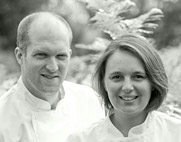
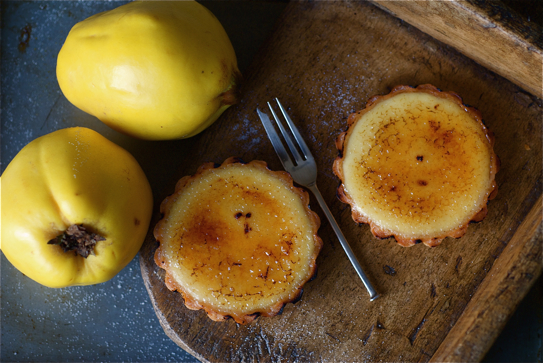

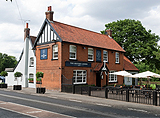
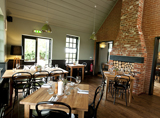
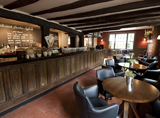
Just made these and they are delicious. We found caster sugar much better than icing sugar for the brûlée crust but apart from that this is a great recipe. Thanks!
Dear Rosie,
The weight is prepared weight.
Happy cooking,
Madalene
This sounds beautiful. Just one question – did you use 400g of quinces *before* peeling and coring, or was that the weight of the actual amount of quince flesh used?
This quince brule is one of the most imaginatice uses of quince. Can you tell us who developed it?
Quince curd sounds wonderful. I can’t wait to try making some as soon as quinces are available here in Australia again.
The memories of quinces I have are two: one eaten the *Spanish* way; quince ate or pate de quince with manchego cheese, the ultimate comfort food at home. The second is even simpler but delicious, eaten raw with some lime juice pour over directly and sprinkled with salt and chili powder. (we love to eat fruits with salt and chili powder in Mexico).
I think it’s time to upgrade the quinces recipes repertoire!
This looks like a great way to use quinces!